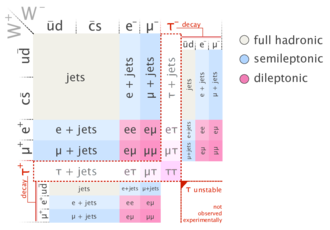Top quark
ħ | |
| Topness | 1 |
|---|---|
| Weak isospin | LH: + 1 /2, RH: 0 |
| Weak hypercharge | LH: +1 /3, RH: +4/3 |
The top quark, sometimes also referred to as the truth quark, (symbol: t) is the most massive of all observed
Like all other
The top quark interacts with
The Standard Model determines the top quark's
Because the top quark is so massive, its properties allowed indirect determination of the mass of the Higgs boson (see § Mass and coupling to the Higgs boson below). As such, the top quark's properties are extensively studied as a means to discriminate between competing theories of new physics beyond the Standard Model. The top quark is the only quark that has been directly observed due to its decay time being shorter than the hadronization time.[b][6]
History
In 1973,
The proposal of Kobayashi and Maskawa heavily relied on the
It was in fact not long until a fifth quark, the bottom, was discovered by the
Early searches for the top quark at
The Tevatron was (until the start of
In the years leading up to the top-quark discovery, it was realized that certain precision measurements of the electroweak vector boson masses and couplings are very sensitive to the value of the top-quark mass. These effects become much larger for higher values of the top mass and therefore could indirectly see the top quark even if it could not be directly detected in any experiment at the time. The largest effect from the top-quark mass was on the
Properties
- At the final Tevatron energy of 1.96 TeV, top–antitop pairs were produced with a pb.
- The W bosons from top quark decays carry polarization from the parent particle, hence pose themselves as a unique probe to top polarization.
- In the Standard Model, the top quark is predicted to have a spin quantum number of 1 /2 and electric charge ++ 2 /3. A first measurement of the top quark charge has been published, resulting in some confidence that the top quark charge is indeed ++ 2 /3.[21]
Production
Because top quarks are very massive, large amounts of energy are needed to create one. The only way to achieve such high energies is through high-energy collisions. These occur naturally in the Earth's upper atmosphere as
Top-quark pairs
The most common is
Single top quarks
The production of single top quarks via
Decay

The only known way the top quark can decay is through the weak interaction, producing a W boson and a bottom quark.[a] Because of its enormous mass, the top quark is extremely short-lived, with a predicted lifetime of only 5×10−25 s.[5] As a result, top quarks do not have time before they decay to form hadrons as other quarks do.[b] The absence of a hadron surrounding the top quark provides physicists with the unique opportunity to study the behavior of a "bare" quark.
In particular, it is possible to directly determine the
The best current determination of this ratio is 0.957±0.034.[25] Since this ratio is equal to |Vtb|2 according to the Standard Model, this gives another way of determining the CKM element |Vtb|, or in combination with the determination of |Vtb| from single top production provides tests for the assumption that the CKM matrix is unitary.[26]
The Standard Model also allows more exotic decays, but only at one loop level, meaning that they are extremely rare. In particular, it is conceivable that a top quark might decay into another up-type quark (an up or a charm) by emitting a photon or a Z-boson.
Mass and coupling to the Higgs boson
The Standard Model generates fermion masses through their couplings to the Higgs boson. This Higgs boson acts as a field filling space. Fermions interact with this field in proportion to their individual coupling constants which generates mass. A low-mass particle, such as the electron has a minuscule coupling while the top quark has the largest coupling to the Higgs,
In the Standard Model, all of the quark and lepton Higgs–Yukawa couplings are small compared to the top-quark Yukawa coupling. This hierarchy in the fermion masses remains a profound and open problem in theoretical physics. Higgs–Yukawa couplings are not fixed constants of nature, as their values vary slowly as the energy scale (distance scale) at which they are measured. These dynamics of Higgs–Yukawa couplings, called "running coupling constants", are due to a quantum effect called the renormalization group.
The Higgs–Yukawa couplings of the up, down, charm, strange and bottom quarks are hypothesized to have small values at the extremely high energy scale of grand unification, 1015 GeV. They increase in value at lower energy scales, at which the quark masses are generated by the Higgs. The slight growth is due to corrections from the QCD coupling. The corrections from the Yukawa couplings are negligible for the lower-mass quarks.
One of the prevailing views in particle physics is that the size of the top-quark Higgs–Yukawa coupling is determined by a unique nonlinear property of the renormalization group equation that describes the running of the large Higgs–Yukawa coupling of the top quark. If a quark Higgs–Yukawa coupling has a large value at very high energies, its Yukawa corrections will evolve downward in mass scale and cancel against the QCD corrections. This is known as a (quasi-) infrared fixed point, which was first predicted by B. Pendleton and G.G. Ross,[28] and by Christopher T. Hill,[29] No matter what the initial starting value of the coupling is, if sufficiently large, it will reach this fixed-point value. The corresponding quark mass is then predicted.
The top-quark Yukawa coupling lies very near the infrared fixed point of the Standard Model. The renormalization group equation is:
where g3 is the color gauge coupling, g2 is the weak isospin gauge coupling, and g1 is the weak hypercharge gauge coupling. This equation describes how the Yukawa coupling changes with energy scale μ. Solutions to this equation for large initial values yt cause the right-hand side of the equation to quickly approach zero, locking yt to the QCD coupling g3.
The value of the top quark fixed point is fairly precisely determined in the Standard Model, leading to a top-quark mass of 220 GeV. This is about 25% larger than the observed top mass and may be hinting at new physics at higher energy scales.
The quasi-infrared fixed point subsequently became the basis of
See also
- CDF experiment
- Quark model
- Top quark condensate
- Topcolor
- Topness
Footnotes
- ^ a b The overwhelming majority of top quark decays produce a bottom quark, whose mass is closest to the top's. On very rare occasions it may decay into a strange quark; almost never a down quark.
- ^ a b c Top quark decay is an exceptional example of a weak process that is faster than a strong interaction.
References
- ^ a b Zyla, P.A.; et al. (Particle Data Group) (2020). "2020 Review of Particle Physics". Progress of Theoretical and Experimental Physics: 083C01.
- ^ a b
Abe, F.; et al. (S2CID 119451328.
- ^ a b
Abachi, S.; et al. (S2CID 42826202.
- ^ Elert, Glenn. "Quantum Chromodynamics". The Physics Hypertextbook. Retrieved 23 March 2019.
- ^ a b
Quadt, A. (2006). "Top quark physics at hadron colliders". S2CID 121887478.
- ISBN 978-0-7923-6436-8. Retrieved 11 June 2020.
- ^ Harari, H. (1975). "A new quark model for hadrons". .
- ^
Staley, K.W. (2004). The Evidence for the Top Quark. ISBN 978-0-521-82710-2.
- ^
Perkins, D.H. (2000). Introduction to High Energy Physics. ISBN 978-0-521-62196-0.
- ^
Close, F. (2006). The New Cosmic Onion. ISBN 978-1-58488-798-0.
- ^ Glashow, S.L.; Iliopoulous, J.; Maiani, L. (1970). "Weak interactions with lepton–hadron symmetry". .
- ^
Pickering, A. (1999). Constructing Quarks: A sociological history of particle physics. ISBN 978-0-226-66799-7.
- ^
Perl, M.L.; et al. (1975). "Evidence for anomalous lepton production in
e+
e−
annihilation". . - ^ "Discovery of the bottom quark" (Press release). Discoveries at Fermilab. Fermilab. 7 August 1977. Retrieved 24 July 2009.
- ^ Lederman, L.M. (2005). "Logbook: Bottom quark". Symmetry Magazine. Vol. 2, no. 8. Archived from the original on 4 October 2006.
- ^
Herb, S.W.; et al. (1977). "Observation of a di‑muon resonance at 9.5 GeV in 400 GeV proton–nucleus collisions". OSTI 1155396.
- ^ a b c d Liss, T.M.; Tipton, P.L. (1997). "The discovery of the top quark" (PDF). .
- ^
"The Nobel Prize in Physics 1999" (Press release). The Nobel Foundation. Retrieved 10 September 2009.
- ^
"The Nobel Prize in Physics 1999" (Press release). The Nobel Foundation. 12 October 1999. Retrieved 10 September 2009.
- ^
Chakraborty, D.; et al. (arXiv:hep-ex/0212027.
- ^
Abazov, V.M.; et al. (S2CID 1147194.
- ^ a b
Abazov, V.M.; et al. (S2CID 14919683.
- ^
Abazov, V.M.; et al. (S2CID 14937909.
- ^
Aaltonen, T.; et al. (S2CID 8029289.
- ^ a b Zyla, P.A.; et al. (Particle Data Group) (2020). "QUARKS" (PDF). Progress of Theoretical and Experimental Physics: 083C01. Retrieved 22 May 2022.
- ^
Abazov, V.M.; et al. (S2CID 2638258.
- ^
Chekanov, S.; et al. (S2CID 119494760.
- ^ Pendleton, Brian; Ross, Graham (1981). "Mass and mixing angle predictions from infrared fixed points". .
- ^ Hill, Christopher T. (1981). "Quark and lepton masses from renormalization group fixed points". .
- ^
Hill, Christopher T.; Machado, Pedro; Thomsen, Anders; Turner, Jessica (2019). "Where are the next Higgs bosons?". Physical Review D. 100 (1): 015051. S2CID 104291827.
- ^
Hill, Christopher T.; Machado, Pedro; Thomsen, Anders; Turner, Jessica (2019). "Scalar democracy". Physical Review D. 100 (1): 015015. S2CID 119193325.
Further reading
- Frank Fiedler; for the D0; CDF Collaborations (June 2005). "Top Quark Production and Properties at the Tevatron". arXiv:hep-ex/0506005.)
{{cite arXiv}}: CS1 maint: numeric names: authors list (link
- R. Nave. "Quarks". HyperPhysics. Georgia State University, Department of Physics and Astronomy. Retrieved 29 June 2008.
- A. Pickering (1984). Constructing Quarks. ISBN 978-0-226-66799-7.
External links
- "Script to retrieve "top quark" on arxiv.org". Archived from the original on 16 January 2022. Retrieved 19 February 2023.
- "Tevatron Electroweak Working Group". Fermilab.
- "Top quark information". Fermilab.
- "CDF and DZero collaborations' top quark discovery". Symmetry Magazine (discovery logbook pages). Archived from the original on 2 October 2006.
- "article on the discovery of the top quark" (PDF). Scientific American.
- "Top quark analysis results from DØ Collaboration". Fermilab (public homepage).
- "Top quark analysis results from CDF Collaboration". Fermilab.
- "article about the 1994 top quark discovery". Harvard Magazine. Archived from the original on 8 May 2006.
- "Nobel Prize in Physics". 1999.












